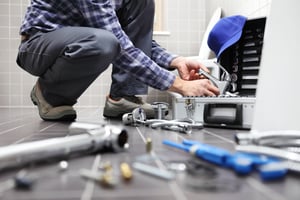 Your home's plumbing system is essential to keeping your standard of living comfortable. If it's not working properly, you won't be able to shower, wash your hands, use the toilet, wash dishes, water the lawn, or run the washing machine. Plumbing systems are responsible for quite a bit; however, most people don't really know what their plumbing system is. They just turn the handle or press a button and expect the water to come out at the precise temperature and pressure they want.
Your home's plumbing system is essential to keeping your standard of living comfortable. If it's not working properly, you won't be able to shower, wash your hands, use the toilet, wash dishes, water the lawn, or run the washing machine. Plumbing systems are responsible for quite a bit; however, most people don't really know what their plumbing system is. They just turn the handle or press a button and expect the water to come out at the precise temperature and pressure they want.
As a homeowner, it's important to have a basic understanding of how your plumbing system works so that you can take better care of it and prevent costly breakdowns. Keep reading to learn the 3 major categories of your home's plumbing system.
Pipes and Fittings
The pipes and fittings are essentially the skeleton of your plumbing system. Pipes are used to transport water from the main city line or well, throughout your home, and finally to the individual places it needs to go. Fittings are the parts that connect each pipe to the next one. Fittings allow the pipes to change angles and make the best use of the space inside your walls, ceilings, and floors. Most plumbing systems will have two sets of pipes and fittings. One set for cold water, and the other for hot. The pipes in your plumbing system will most likely be made of copper, brass, PVC, or lead.
Fixtures
As your pipes carry water throughout your home, that water needs an ultimate place to go. That's where fixtures come in. Fixtures are things like bathroom sinks, kitchen sinks, tubs and showers, water heaters, dishwashers, washing machines, and any other appliance in your home that requires water. Some of these fixtures draw water on an as-needed basis, while others draw water from the pipes at the turn of a handle or press of a button.
Drainage
Once the water travels through your pipes and out your fixtures, it needs a place to go. Without a drainage system in place, your house would quickly get flooded after a couple of showers. Each fixture has its own drain that connects to the main drain line where excess water and any other waste that goes down the drain will eventually end up in the city sewer or your own septic system. It's important to make sure that your drains are cared for properly because if they get backed up and start overflowing, it can be both a messy and smelly problem to deal with.
That's your home's plumbing system in a nutshell. It is much more complex than this, but with these basics in mind, you will hopefully have a better understanding of how your plumbing works and where a potential problem could be. If you would like more information about plumbing, have any questions regarding your plumbing system, or you're experiencing a problem and need professional help, The expert plumbers at Ken's would be happy to help! Just give us a call at (864) 392-5498 or contact us online here!


.png)